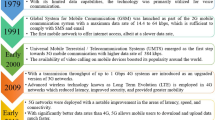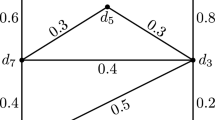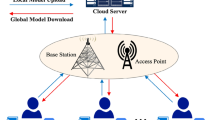Abstract
In this paper, load balancing problem is investigated and a new game theory automatic load balancing scheme in LTE networks is proposed based on non-cooperative differential game. Optimal load allocated to each cell is formulated as a Nash Equilibrium in this paper. It is proved that the non-cooperative differential game algorithm is applicable and the optimal load solution can be achieved. Simulation results show that system capacity is increased and load unbalancing caused inappropriate load allocation is decreased.
Similar content being viewed by others
References
NGMN use cases related to self organizing network, overall description, May 2007.
Self-Organizing Networks (SON). (2008). 3GPP long term evolution, Sujuan Feng, Eiko Seidel, Nomor Research GmbH, Munich, Germany, May 2008.
The Benefits of SON in LTE, 3G Americas, December 2009.
3GPP TS 32.500 V11.00. 3rd (2011-06). Self-Organizing Networks (SON) Concepts and Requirements (Release 11).
3GPP TR 36.902 V9.3.1. (2011-03). Self-configuring and self-optimizing network use cases and solutions.
Awada A., Viering I., Wegmann B., Klein A. (2011) Application of game theory for load balancing in long term evolution networks. Frequenz 64(9–10): 180–184. doi:10.1515/FREQ.2010.64.9-10.180
The SOCRATES Project, EB/OL. http://www.fp7-socrates.eu.2009.
Zhang, H., Qiu, X.-S., Meng, L.-M., & Zhang, X.-D. (2010). Achieving distributed load balancing in self-organizing LTE radio access network with autonomic network management. In GLOBECOM workshops (GC Wkshps), 2010 IEEE, pp. 454–459, 6–10 December 2010.
Dixit A. K. (1979) Model of duopoly suggesting a theory of entry barriers. The Bell Journal of Economics 10: 20–32
Yeung D. W. K. (2007) Dynamically consistent cooperative solution in a differential game of transboundary industrial pollution. Journal of Optimization Theory and Applications 134(1): 143–160
3GPP Tdoc R3-070562. (2007). Self-optimization use case: Self-tuning of handover parameters 27–30 March, 2007.
3GPP Tdoc R3-072249. (2007). Load balancing use case involving cell reselection and handover parameters self optimization. 05–10 November 2007.
Muñoz, P. Barco, R., de la Bandera, I., Toril, M., & Luna-Ramirez, S. (2011). Optimization of a fuzzy logic controller for handover-based load balancing. In Vehicular technology conference (VTC Spring), 2011 IEEE 73rd, pp. 1–5, 15–18 May 2011.
Zhang, H., Qiu, X., Meng, L., & Zhang, X. (2010). Design of distributed and autonomic load balancing for self-organization LTE. In Vehicular technology conference fall (VTC 2010-Fall), 2010 IEEE 72nd, pp. 1–5, 6–9 September 2010.
Viering, I., Dottling, M., & Lobinger, A. (2009). A mathematical perspective of self-optimizing wireless networks. In IEEE international conference on communications, 2009. ICC ’09, pp. 1–6, 14–18 June 2009.
Awada, A., Wegmann, B., Viering, I., & Klein, A. (2010). A game-theoretic approach to load balancing in cellular radio networks. In 21st IEEE international symposium on personal indoor and mobile radio communications (PIMRC), 2010, pp. 1184–1189, 26–30 September 2010.
He, H., Wen, X., Zheng, W., Sun, Y., & Wang, B. (2010). Game theory based load balancing in self-optimizing wireless networks. In The 2nd international conference on Computer and automation engineering (ICCAE), 2010, Vol. 4, pp. 415–418, 26–28 February 2010.
3GPP TS 32.521 V10.1.0. (2010–2012). Self-organizing networks (SON) policy network resource model (NRM) integration reference point (IRP), requirements (2010–2012).
Author information
Authors and Affiliations
Corresponding author
Rights and permissions
About this article
Cite this article
Xu, H., Zhou, X. & Chen, Y. A Differential Game Model of Automatic Load Balancing in LTE Networks. Wireless Pers Commun 71, 165–180 (2013). https://doi.org/10.1007/s11277-012-0809-x
Published:
Issue Date:
DOI: https://doi.org/10.1007/s11277-012-0809-x




